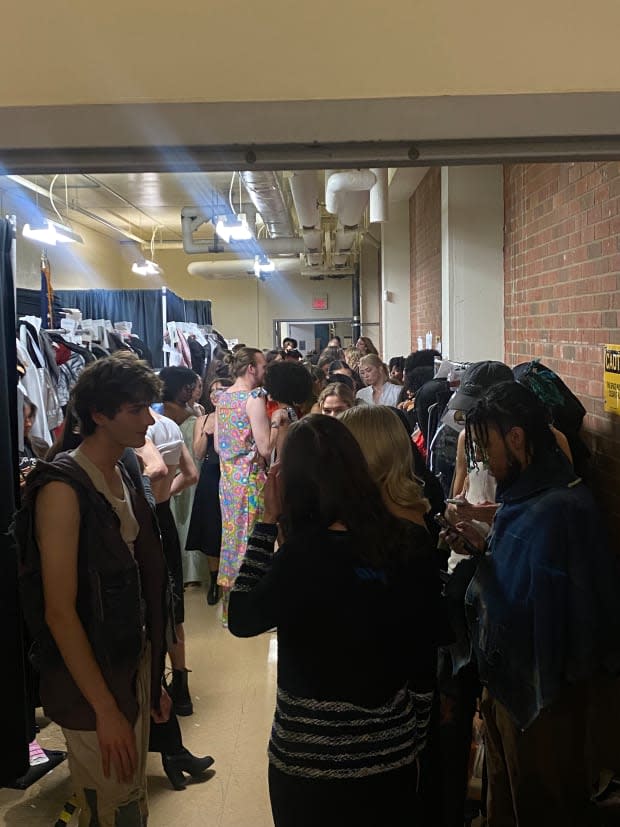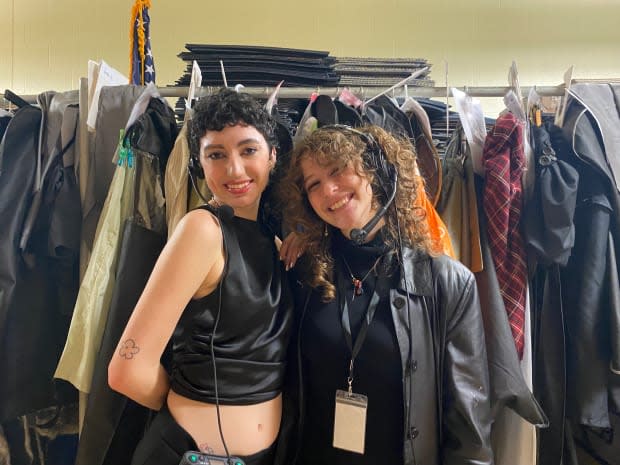What It's Like Working Backstage at a Fashion School Runway Show
No matter what aspect of the industry fashion students are looking to be a part of, there's one thing all of us aspiring creatives can agree on: You can't move on from fashion school until you've been a part of a runway show.
This semester, I had the opportunity to be on Kent State University's student production team for its annual fashion show, which, in 2023, also marked Kent State Fashion School's 40th anniversary. Four months' worth of work came together last week, when, from April 26 to April 29, guests walked into the Kent State Ballroom, found their front-row seats and got to take in the intricate work and detailing the designers put into their collections. Going by the thundering round of applause given after each night, I think it's safe to say that it was a success.
Granted, I'm referring to what I heard, since I didn't see any of it. I was backstage with the rest of the production team, and let's just say, my experience differed from the perspective of the guests on the other side of the Ballroom wall. Here's a breakdown of how it all went down.
Leading up to the show(s)

Photo: Courtesy of Janelle Sessoms
The planning process really went into full force back in January — garments had yet to be completed, a draft for the model call was in its early stages, the venue location was still uncertain... So, the grind began.
Each week, the student production team made significant headway, from putting on design critiques for industry professionals to give feedback on the collections to assisting with the professional filming of the video that would capture each student's work. We threw any and all energy into making this the best runway production we could possibly put on.
Within a couple of months, we'd secured models, finished critiques, completed the fashion film and organized racks of already-submitted looks. As designers finalized pieces for the runway, all that was left was show day(s).
Day of the show(s)

Photo: Courtesy of Janelle Sessoms
Just like for any major fashion show, there are tasks that need to be done hours before the actual production begins.
For the front of house, ushers double-checked that each row of seats was perfectly aligned, every chair had a program and there was not a hint of trash anywhere on the premises. I was backstage, where dressers and merchandise coordinators checked each garment to see if it needed any steaming, assured every rack was organized and triple-checked each garment bag had the correct tag, with proper styling directions and photos for reference.
About an hour before each show started, models started getting dressed. Once they were in their looks and waiting in line to walk, there really wasn't anything left to do except wait for the show to begin.
Night of the show(s)

Photo: Courtesy of Ella Hurrelbrink
Once the first beat of the opening song dropped, you could feel the adrenaline rush in the air. Even after that first night, the number of nerves and excitement in the room never leveled down — if anything, it kept going up.
For the first few minutes, there was a relative amount of peace. Then the models began to come back for their outfit changes. One word: chaos. (My vocabulary for the evening solely consisted of "take this off," "put this one," "move," "go" and "oh my god.")

Photo: Courtesy of Ella Hurrelbrink
Each show featured 112 looks. There were seven clothing racks backstage, each with a minimum of three dressers working at lightning speed to ensure the models made it down the catwalk in time. My fellow merchandising coordinators and I worked on the "Quick Change" rack, which consisted of garments for models who had no more than a couple of minutes to change and get back on the runway.
It wasn't just the clothes we had to account for: We were swapping shoes, removing accessories, styling to perrfection — all in a couple of minutes. At the end of the day (or should I say night), no models missed their cues. Each show went on without a hitch.
After the show(s)
Once the final show night wrapped up, the whole team took a big sigh of relief. We could pat ourselves on the back for a job well done and catch up on some much-needed sleep. The breakdown process wasn't nearly as extensive as you may think — the most important thing was assuring every garment was accounted for and securely wrapped up for designers to retrieve in the coming days. The hard part (and most fun) was over: Another time well spent, show well done and a final semester for the books.

Photo: Courtesy of Janelle Sessoms

Photo: Courtesy of Janelle Sessoms

Photo: Courtesy of Ella Hurrelbrink

Photo: Courtesy of Ella Hurrelbrink

Photo: Courtesy of Hope Aurand

Photo: Courtesy of Janelle Sessoms

Photo: Courtesy of Janelle Sessoms

Photo: Courtesy of Janelle Sessoms

Photo: Courtesy of Janelle Sessoms
Never miss the latest fashion industry news. Sign up for the Fashionista daily newsletter.
